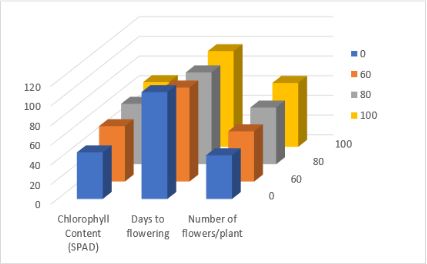Influence of Salicylic Acid on The Vegetative and Reproductive Attributes of Sweet Pea
Keywords:
Sweet Pea, Salicylic Acid, Vegetative Attributes, Reproductive attibutes, Early FloweringAbstract
Sweet pea is an important cut flower and a garden plant. Its growth needs to be optimized for quality flower production. In this regard, a study on the influence of salicylic acid on the vegetative and reproductive attributes of sweet peas was conducted at the ornamental nursery, Horticulture Department, University of Agriculture Peshawar, Pakistan. The experiment was conducted in RCBD arrangement with a single factor i.e. salicylic acid (SA) whose concentrations were 0, 60, 80, and 100mgL-1. All the treatments were replicated three times. The results showed that SA at the rate of 100 mgL-1 resulted in maximum number of branches plant-1 (43.733), number of leaves plant-1 (71.667), chlorophyll content (65.84 SPAD), and number of flowers plant-1 (65.02) of sweet pea which were statistically similar to the results obtained when the SA at the rate of 80mgL-1 was applied to the plants. The maximum plant height (343.40cm) and minimum days to flowering (93.33 days) were noted when the plants were sprayed with 80 mgL-1 of SA. The minimum number of branches plant-1 (33.400), number of leaves plant-1 (63.167), Plant height (325.53 cm), chlorophyll content (47.42 SPAD), number of flowers plant-1 (44.45) and maximum days to flowering (108.67 days) were observed in control. Keeping in view the above results it was recommended that SA at the rate of 80 mg/L be used for enhanced vegetative and reproductive attributes of sweet pea.


















